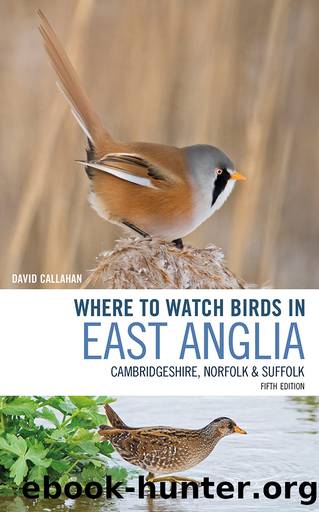Where to Watch Birds in East Anglia by David Callahan

Author:David Callahan
Language: eng
Format: epub
Publisher: Bloomsbury
Published: 2020-11-15T00:00:00+00:00
EXPECTED SPECIES
Year-round
Western Marsh Harrier
Western Barn Owl
Spring/summer
Sand Martin another hirundines
Winter
Geese (mostly overhead)
Commoner winter wildfowl
Short-eared Owl
Passage
Little Gull
Black Tern
Drift migrants and rarities
Description
Despite the plainness of the habitats â one modest pool, grazing marsh, arable land and dunes beyond â Kelling has garnered a fair reputation for attracting scarce and rare birds over the years, due to its position in the middle of the North Norfolk regional hotspot. The location certainly pays off for regular visitors and patch watchers â though it can be hard work at times â but Meadow Lane and Kelling Water Meadows (aka Kelling Quags) are the places for attracting the birds in the area. The Quags are managed by NOA and the Kelling Estate together.
There are hedgerows for feeding thrushes and finches, water for gulls, terns and wildfowl, muddy edges for waders and fields for other waders, along with larks, pipits and wagtails. The odd seabird can be glimpsed above the dunes, but these obscure most of the sea from your eyeline.
Facilities
There are no facilities on site, but Kelling has a rustic cafe-cum-bookshop with refreshments, nice cakes and pasties, and some toilets. The site is within easy reach of several major towns if more choice is required.
Strategy and timing
As with most North Norfolk birding locations, Kelling is best during passage periods though there is much entertainment year-round.
After parking, head down the track, but pay attention to the fields and hedges, as both Common (âMealyâ) and Couesâs Arctic Redpolls are fairly regular among the Lesser Redpoll flocks sometimes present in winter (though these are very mobile and can wander into the woods inland at times), while Brambling and winter thrushes are also likely.
In spring and summer there will be plenty of the commoner warblers, while in spring and especially autumn, species such as Spotted and Pied Flycatchers and Common Redstart are also possible.
After a third of a mile or so, you will notice a small, reed-fringed lake to your right, somewhat obscured by high brambles, though there are a couple of places you can peek through at the assembled gulls which loaf at the site â Mediterranean and Little Gulls can occur, and White-winged Black Tern has been known. To get the most out of this quite small area of water, a scope is advisable.
A decent variety of the most likely wildfowl species also visit outside the breeding season, including common Shelduck, Gadwall and Eurasian Wigeon, but Garganey can drop in to provide a bit more interest in spring. The incipient nesting season will also see good numbers of hirundines and swifts whipping through the site well into summer, while Black, Sandwich, Common, Arctic and Little Terns may all put in an appearance, although usually brief.
Lower water levels will coax in a spread of migrating waders at the right time of year, with Common, Green and Wood Sandpipers, Ruff and Common Greenshank among the more likely visitors. The odd American or Siberian vagrant has been found, so pay careful scrutiny during passage periods.
European Reed and Sedge Warblers and Common Reed
Download
This site does not store any files on its server. We only index and link to content provided by other sites. Please contact the content providers to delete copyright contents if any and email us, we'll remove relevant links or contents immediately.
The Lonely City by Olivia Laing(4717)
Animal Frequency by Melissa Alvarez(4372)
All Creatures Great and Small by James Herriot(4197)
Walking by Henry David Thoreau(3864)
Exit West by Mohsin Hamid(3749)
Origin Story: A Big History of Everything by David Christian(3596)
COSMOS by Carl Sagan(3519)
How to Read Water: Clues and Patterns from Puddles to the Sea (Natural Navigation) by Tristan Gooley(3376)
Hedgerow by John Wright(3245)
How to Read Nature by Tristan Gooley(3217)
The Inner Life of Animals by Peter Wohlleben(3207)
How to Do Nothing by Jenny Odell(3204)
Project Animal Farm: An Accidental Journey into the Secret World of Farming and the Truth About Our Food by Sonia Faruqi(3146)
Origin Story by David Christian(3121)
Water by Ian Miller(3093)
A Forest Journey by John Perlin(3012)
The Plant Messiah by Carlos Magdalena(2843)
A Wilder Time by William E. Glassley(2795)
Forests: A Very Short Introduction by Jaboury Ghazoul(2768)
